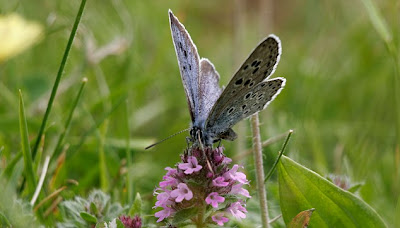 Butterfly effect: The loss of the High Brown Fritillary would affect the ecosystyem
Butterfly effect: The loss of the High Brown Fritillary would affect the ecosystyemSome of our most beautiful and popular butterflies could vanish from the countryside within years, experts warn.
Thirty-seven per cent of native species are either under threat of extinction or have already died out, a study shows.
They have been so badly hit by the rise of intensive farming and loss of habitats that they are now faring worse than any other group of domestic wildlife.
As butterflies determine the health of the environment, conservationists say their decline affects other wildlife.
The warning came as the Butterfly Conservation charity published a list of the 23 species that are endangered or already extinct.
A further 11 of our 72 butterflies are rated as ‘near threatened’, so only about half are considered safe.
The list includes the high brown fritillary, which has seen numbers drop by 85 per cent over ten years.
 The handsome speckled insect once bred in woods in Wales and the South.
The handsome speckled insect once bred in woods in Wales and the South. However, it is now found in just 30 small colonies in the South West, South Wales and Cumbria. Another endangered species is the large blue. It was wiped out in the 1970s, but has been reintroduced to chalky hillsides in the South West.
Its caterpillars mimic the scent of red ant grubs to fool worker ants into taking them into the nest. Once inside, the caterpillars eat the ant grubs.
Butterfly Conservation spokesman Richard Fox said: ‘The new Red List shows that the number of butterflies in need of help has increased dramatically in the past ten years.
 Sight for sore eyes: White Letter Hairstreak Stryminidia butterfly
Sight for sore eyes: White Letter Hairstreak Stryminidia butterfly‘We have seen conservationists bring the large blue back from extinction.
‘But there is much more we need to do to secure the future. They are our heritage.’
The Red List is based on data collected by thousands of volunteers organised by the charity and Centre for Ecology and Hydrology in Oxfordshire.
Butterflies suffer from the loss of grasslands rich in wild flowers and poorer quality of woodlands. Pesticides and intensive farming are also to blame.
According to studies, 21 per cent of dragonfly species, 29 per cent of birds and 20 per cent of plants are endangered in the UK.
 Rare sight: Large Blue butterfly feeding on wild thyme
Rare sight: Large Blue butterfly feeding on wild thymeResearch confirms that butterflies are faring worse than dragonflies, birds and plants, with 37% of Britain's 59 native species considered regionally extinct or threatened.
This compares to 21% of dragonflies, 29% of birds and 20% of plants. A further 11 butterfly species are classified as 'near threatened' in the new list, leaving fewer than half (45 per cent) of Britain's butterflies safe - for now.
The figures are the result of a major re-assessment of the state of British butterfly populations using the International Union for Conservation of Nature (IUCN) 'red list' approach.
source: dailymail















+The+quirky+new+calendar+that+uses+pets+to+spoof+the+rich+and+famous+1.jpg)


+1.jpg)